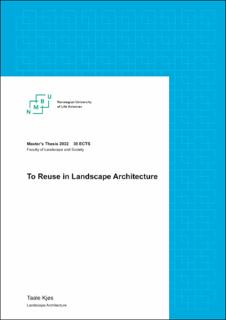| dc.description.abstract | The climate is changing, the global population is growing, and urbanization is accelerating. In the effort of mitigating greenhouse gas emissions, raise living standards, and accommodating the growing cities with enough and adequate dwellings in a sustainable way, another crisis is unfolding. Resource scarcity has become a major issue in the battle for a better and more sustainable planet. Building better and more sustainable is one of the key solutions to mitigate greenhouse gas emissions, but how do we do that if we run out of resources to build with? Tackling both climatic change and resource scarcity without lowering the global living standards has made the world look for new solutions, and a circular economy has been lauded as a method to do so. This thesis looks into the state of the world regarding climate and resources, what a circular economy really is, and how landscape architecture relations to the built environment and circular economy is as a method of reusing construction materials. | en_US |

